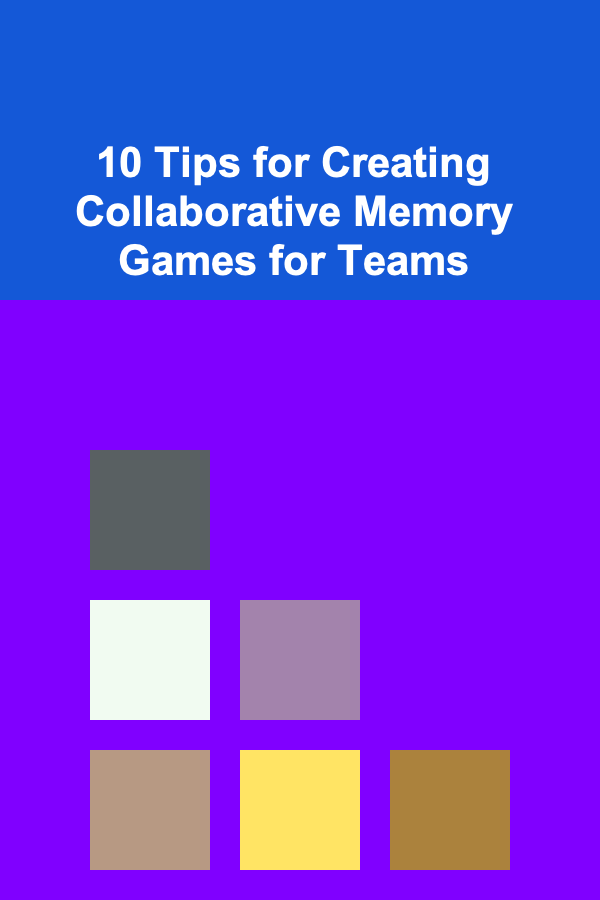
10 Tips for Creating Collaborative Memory Games for Teams
ebook include PDF & Audio bundle (Micro Guide)
$12.99$9.99
Limited Time Offer! Order within the next:

Memory games are not only fun but also a powerful tool to enhance team collaboration, problem-solving, and cognitive skills. When you integrate memory challenges into team activities, you create an engaging and effective way to boost group dynamics, improve communication, and strengthen team bonds. Whether in a corporate setting, educational environment, or casual group gathering, memory games can serve as an excellent bonding experience.
In this article, we will explore 10 tips for creating collaborative memory games tailored for teams. These tips will help you design games that are both enjoyable and beneficial, promoting cooperation and helping teams work together more efficiently.
Understand the Purpose of the Game
Before designing a memory game, it's crucial to understand the primary objective. Is the goal to boost team morale, enhance problem-solving skills, improve focus, or simply have fun? Having a clear purpose in mind will guide you in creating a game that addresses specific team needs.
Consider the following:
- Team Dynamics: What is the current level of collaboration in the team? If the team already works well together, the game could focus more on creative thinking or complex memory challenges. If the team needs more work on communication and trust, a simpler game that encourages interaction might be more appropriate.
- Skill Development: Are you aiming to improve specific cognitive skills like recall, concentration, or associative memory? Tailoring the game's difficulty level to the team's current skill set is important.
Incorporate Team-based Challenges
One of the key elements of collaborative memory games is teamwork. Instead of relying on individual performance, design games where team members must rely on each other's strengths. Collaborative memory games can strengthen communication and foster a deeper connection between team members.
Game Ideas:
- Group Story Recall: Present a short story or series of images and ask each team member to recall and add a part of the story. As the story progresses, team members will need to remember what others have added, requiring collaboration and active listening.
- Shared Lists: Create a list of items or concepts and ask each team member to recall a few items. The team as a whole must work together to recall every item on the list. This encourages joint effort and active memory engagement.
Use Visual and Audio Stimuli
Our brains process both visual and auditory information, but often, one type of stimuli might be more effective depending on the game's purpose. Incorporating a mix of visual and auditory elements can increase engagement and create a more dynamic challenge for team members.
Visual and Auditory Integration:
- Memory Cards: Use cards with images or words, where participants must match pairs based on memory. The game can be played in pairs or small teams, where each member must describe an image or word they saw earlier, without showing it to others.
- Sound-Based Challenges: Play a series of sounds or words and ask teams to remember and repeat them in the same order. This adds a different layer of difficulty by integrating auditory memory.
Introduce Time Pressure
While memory games are effective for improving recall, adding a time pressure element can make them more exciting and engaging. When teams know they are racing against the clock, it can push them to focus more intensely and collaborate quickly.
Time-based Challenge Ideas:
- Speed Memory Challenge: Give teams a short amount of time to memorize a set of words, numbers, or images. After the time is up, challenge them to recall as many as they can, with the team that remembers the most winning the game.
- Countdown Round: In this variation, the team has to complete multiple rounds of memory tasks in increasingly shorter time frames, encouraging fast thinking and teamwork.
Add Layers of Complexity
To keep things interesting, gradually increase the complexity of the memory challenges as the game progresses. This helps to engage different cognitive skills and ensures that the game remains challenging and stimulating for everyone.
Complexity Enhancement Ideas:
- Multi-step Tasks: Instead of a single memory task, create a sequence of interconnected challenges. For example, teams may first need to memorize a set of images, then use those images to solve a puzzle or answer questions later in the game.
- Mix Memory Types: Combine different types of memory challenges, such as visual, verbal, and spatial. This forces the team to adapt and think creatively, improving their overall cognitive flexibility.
Incorporate Collaboration Tools
While memory games are typically centered around the individual's ability to recall, incorporating tools that allow for easy sharing and communication can encourage collaborative problem-solving. Using tools such as whiteboards, shared digital documents, or sticky notes can facilitate easier interaction and teamwork.
Collaboration-enhancing Ideas:
- Shared Digital Space: Use a shared Google Doc or online whiteboard where players can jot down their memories, hints, or clues. This way, everyone can see each other's thoughts and contribute to solving the memory challenge.
- Physical Objects: In a physical setting, teams can work together to manipulate objects, like moving pieces of a puzzle or arranging physical cards on a table. This provides a tactile, hands-on experience that encourages teamwork.
Create Storytelling Memory Games
Memory and storytelling often go hand in hand. Creating a memory game that involves storytelling can make it more immersive and engaging for the team. Stories naturally involve characters, plot, and context, which can all be tied into a memory challenge.
Story-based Game Ideas:
- Sequential Story Recall: Present a story where each team member is responsible for remembering and adding a detail. The challenge is that the story builds with each addition, requiring participants to recall and remember what has been added before their turn.
- Character Memory: Each participant is given a character or object from a story. They must then recall all characters or items in the correct sequence. This forces collaboration and improves both individual and collective recall.
Encourage Group Problem-Solving
Memory games that require problem-solving push teams to collaborate and use critical thinking skills. By adding an element of logic or strategy, you can create a more intellectually stimulating game while still focusing on memory.
Problem-solving Game Ideas:
- Memory Maze: Design a maze that the team must navigate by remembering previous steps or clues. To advance, they must recall specific patterns or routes from earlier rounds, testing both memory and problem-solving abilities.
- Puzzle Pieces: Distribute puzzle pieces among team members, with each piece containing information to solve a larger puzzle. Players must collaborate and share their knowledge of what each piece contains in order to solve the final challenge.
Ensure Inclusivity and Equal Participation
Memory games should be designed in a way that encourages all team members to participate equally. If certain individuals dominate the game or others are left out, the collaborative spirit is diminished. Consider the skill levels of all participants and ensure that the game fosters inclusivity.
Inclusivity Tips:
- Rotate Roles: Ensure that team members take turns in leading the memory challenges. This promotes fairness and allows everyone to contribute equally.
- Pairing Individuals: If the group is large, consider creating smaller teams or pairs to allow for more direct involvement. Pairing people with different strengths (e.g., some are better at visual memory, others at verbal recall) can promote balanced teamwork.
Provide Feedback and Reflection
Once the game is over, take time to reflect on the experience. Group discussions and feedback sessions allow team members to share their thoughts and insights on the process. This not only helps in improving future games but also strengthens the lessons learned about communication and teamwork.
Reflection Ideas:
- Post-Game Discussion: After each round, ask participants to share strategies that helped them remember things, discuss challenges they faced, and highlight moments where teamwork made a difference.
- Learning Outcomes: Ensure that participants are able to link the memory game experience to real-world teamwork situations, whether in problem-solving, project management, or communication.
Conclusion
Creating collaborative memory games for teams is a highly effective way to engage participants, strengthen teamwork, and enhance cognitive abilities. By incorporating creativity, complexity, and collaboration into the design of these games, you not only improve memory recall but also promote important team-building skills such as communication, problem-solving, and mutual support. The key to a successful game lies in understanding the team's needs, encouraging equal participation, and providing opportunities for reflection. Whether you're creating a memory game for work, school, or social groups, these 10 tips will help you design an experience that fosters collaboration, enhances memory, and strengthens bonds.
Reading More From Our Other Websites
- [Weaving Tip 101] Choosing the Right Materials: Yarns, Fibers, and Dyes for Tapestry Weaving
- [Organization Tip 101] How to Create a Tidy and Inviting Guest Room
- [Scrapbooking Tip 101] Turning Everyday Moments into Timeless Keepsakes: Creative DIY Projects
- [Organization Tip 101] How to Designate a Space for Seasonal Craft Projects
- [Home Party Planning 101] How to Host a Successful Potluck Party with a Guest-Submitted Menu
- [Sewing Tip 101] Seasonal Switch-Ups: Transform Your Closet with Smart Clothing Modifications
- [Simple Life Tip 101] How to Host a Simple Potluck Dinner Party That Builds Community---Stress‑Free
- [Home Staging 101] How to Stage Your Home to Sell as a Luxury Property
- [Simple Life Tip 101] Best Low‑Impact Holiday Traditions for Eco‑Focused Families
- [Personal Investment 101] How to Turn Your Deep Learning Skills into Long-Term Passive Income

How to Add a Home Gym During Your Renovation
Read More
How to Choose the Best Party Theme for Your Next Home Celebration
Read More
How to Create a Smart Storage System for Small Apartments
Read More
How to Keep Your Pet Safe During the Holiday Season
Read More
How To Understand Dessert Wines and Fortified Wines
Read More
How to Identify Bull and Bear Markets
Read MoreOther Products

How to Add a Home Gym During Your Renovation
Read More
How to Choose the Best Party Theme for Your Next Home Celebration
Read More
How to Create a Smart Storage System for Small Apartments
Read More
How to Keep Your Pet Safe During the Holiday Season
Read More
How To Understand Dessert Wines and Fortified Wines
Read More